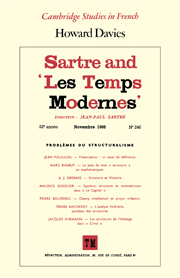Book contents
- Frontmatter
- Contents
- GENERAL EDITOR'S PREFACE
- Preface
- Acknowledgements
- Introduction
- 1 The first six years: the participation of Leiris and Lévi-Strauss
- 2 From 1951 to 1956: the rise of structuralism
- 3 Algeria: intellectual rivalries in time of war
- 4 The critique of academic knowledge
- Conclusion
- Appendix 1 Composition of the Editorial Board
- Appendix 2 Circulation figures
- Appendix 3 Categories of material to be found in Les Temps Modernes
- Appendix 4 Articles pertaining to academic anthropology
- Appendix 5 Special issues
- Notes
- Select bibliography
- Name index
- Subject index
- Cambridge Studies in French
Appendix 3 - Categories of material to be found in Les Temps Modernes
Published online by Cambridge University Press: 05 February 2012
- Frontmatter
- Contents
- GENERAL EDITOR'S PREFACE
- Preface
- Acknowledgements
- Introduction
- 1 The first six years: the participation of Leiris and Lévi-Strauss
- 2 From 1951 to 1956: the rise of structuralism
- 3 Algeria: intellectual rivalries in time of war
- 4 The critique of academic knowledge
- Conclusion
- Appendix 1 Composition of the Editorial Board
- Appendix 2 Circulation figures
- Appendix 3 Categories of material to be found in Les Temps Modernes
- Appendix 4 Articles pertaining to academic anthropology
- Appendix 5 Special issues
- Notes
- Select bibliography
- Name index
- Subject index
- Cambridge Studies in French
Summary
The pie-charts below show, for each of the five periods studied, the amount of space, expressed as a percentage of the whole, which is given to different categories of feature article. A number of points should be borne in mind. The first is that the periods are not of equal length, having been delimited not to facilitate statistical analysis but to highlight the role of academic anthropology within the synthetic. It follows that the curves to be extrapolated from the charts have only limited usefulness. Secondly, the unit of account is not the page but the article. This may vary greatly in length, but an average is between fifteen and twenty pages. Serialised texts have been counted according to the number of parts. Thirdly, the categorisation is broad and corresponds to the assumed intuitions of a typical reader, as well as to the divisions of labour from time to time announced by the Editorial Board. It is also naive, in the sense that it breaks the synthetic whole into discrete and banal sections and negates the disciplinary subversion promoted by Sartre. ‘Saint Genet’, for example, which appeared in 1950 in six parts and straddles every category, is designated as literature. The categories are as follows:
(a) politics (pol.): political and economic theory, analysis and commentary, feminism;
(b) literature (lit.): theory of literature, literary criticism, poetry and literary prose;
[…]
- Type
- Chapter
- Information
- Sartre and 'Les Temps Modernes' , pp. 218 - 221Publisher: Cambridge University PressPrint publication year: 1987
- 1
- Cited by

